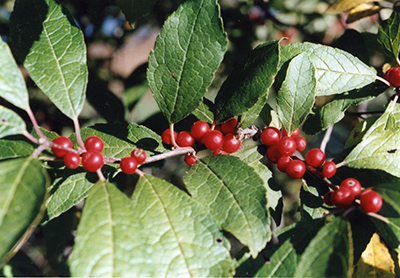Winterberry Hollies
Winterberry Hollies
It is easy to spot winterberry hollies in winter because of the bright, colorful, often shiny and red berries clinging to the branches. The dark green leaves of autumn slowly change to a bright golden yellow. A couple of hard frosts and the leaves drop, at which point the berries become a sight to behold.
Winterberry hollies, also known as deciduous hollies—meaning they shed their leaves at the end of the growing season—are a very important part of every landscape. They can be used as specimen plants around the foundation of your home, or as a small tree or shrub in the side yard. They will flourish in sun or light shade, but if grown in deep shade the bush usually becomes too tall and skinny because the growth will elongate, trying to reach more sun.
Many of the taller-growing winterberry hollies will develop an umbrella-like shape as they mature. These tall varieties—Warren’s Red, Sparkleberry, Bonfire, Winter Gold and Winter Red—will mature to a height of 10 to 12 feet and spread about 8 feet. Most will have multiple stems, a normal part of the natural beauty of winterberry holly.
Warren’s Red holly has bright red berries in great abundance. Sparkleberry is a hybrid cross from the U.S. National Arboretum and has bright coppery-colored new leaf growth in spring and many dark red berries. Winter Gold has colorful pinkish-gold berries. Winter Red has intense red berries in winter.
The smaller varieties of winterberry holly will grow to only 4 or 5 feet tall, with a round or mounded shape. The popular small varieties are Afterglow, Aurantiaca, Earlybright, Sunset, and Red Sprite. Afterglow has orange-red to orange berries. Aurantiaca has attractive red to orange-red berries. Earlybright is one of the earliest to color, in late summer, with bright orange-red berries. Red Sprite has large berries of bright red and grows naturally into a 3 or 4 foot ball-shaped shrub with thousands of berries.
Most hollies are dioecious—having male and female flowers borne on separate plants. I mention this because you will need a male holly within 300 feet (some experts say 900 feet) of your female holly so it can be pollinated, in order for it to produce berries. Any male holly, whether it be evergreen or deciduous, that blooms at the same time as your female holly will pollinate the female. Many male varieties have been selected, but the easiest to find are Apollo, Jim Dandy, Southern Gentleman and Red Escort—if none already exist in your neighborhood. On our farm we have four or five male hollies scattered around to pollinate the female hollies, of which we have many.
Dozens of our favorite songbird species use hollies for food, cover and nesting. Hollies are a great way to attract wildlife to your yard.
Find more holly information at The American Holly Society website: www.hollysocam.org.
Ken O’Dell is the Kansas City Regional Leader of the Kansas Native Plant Society. He is also a long time volunteer at the Overland Park Arboretum.

